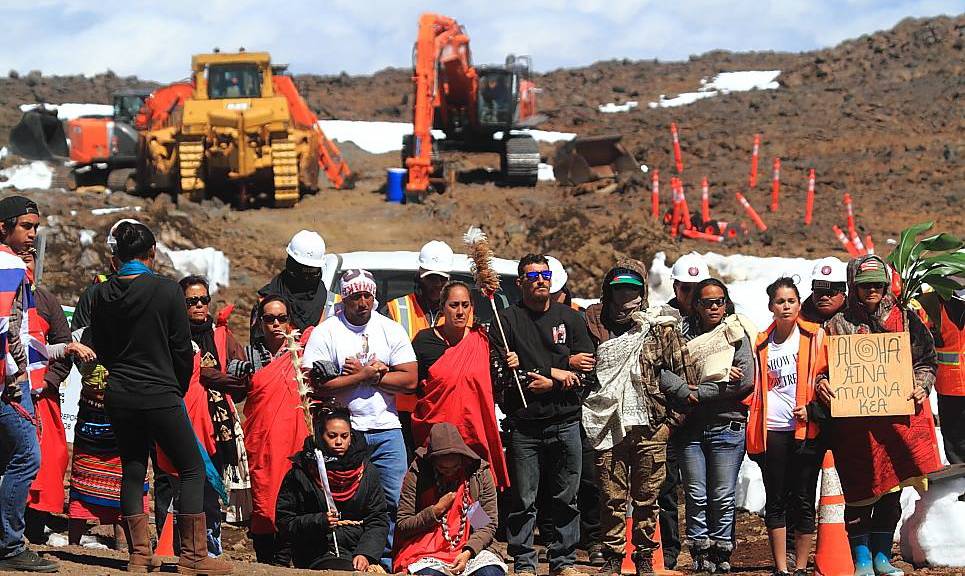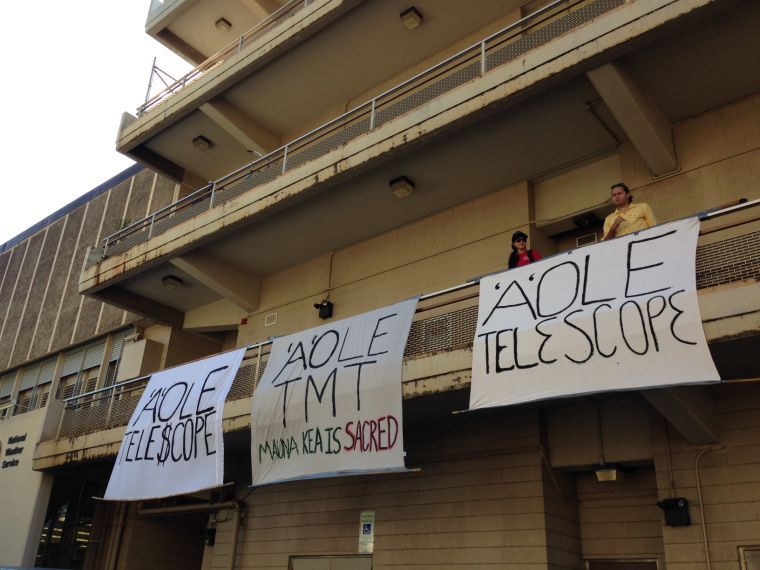
Protecting Mauna Kea: Why the Mountain?
By Will Falk / Deep Green Resistance
I am preparing to leave for Hawai’i to offer myself in support of resistance to the Thirty Meter Telescope (TMT) project that would place a large telescope and stadium-sized structure on the peak of native Hawaiians’ most sacred place – Mauna Kea.
The project, funded by a partnership including the University of California, the California Institute of Technology, and the Association of Canadian Universities for Research in Astronomy among others, would also place a 5,000 gallon chemical waste container above the largest freshwater aquifer on Hawai’i Island.
I first heard about this struggle from the brilliant documentary film-maker Anne Keala Kelly when she spoke at the Earth at Risk conference in San Francisco organized by the Fertile Ground Environmental Institute last fall. I was beyond excited when a friend recently put me in touch with Keala explaining that the Mauna Kea protectors seek more support from the mainland.
It’s been over a year, since I gave up on the possibility that – as a white settler – I will ever truly be able to call stolen native land “home.” Instead of settling into one place, I believe I can be more effective traveling in support of indigenous sovereignty. So, after a wonderfully encouraging conversation with Keala, I am resolved to go.
The first practical step towards getting to Hawai’i is finding the funding. After some donations from friends and a generous offer from the organization that originally introduced me to the struggle at Mauna Kea – Fertile Ground – it looks like I will be set to leave in the next couple weeks.
Before I go, however, it is important to articulate exactly why I am going. Why is stopping the construction of a telescope on top of a mountain thousands of miles away so important? Why, with all the social ills in the world, are you headed to Hawai’i, Will? Or, to borrow the phrase forming the title of Keala’s current documentary film project, “Why the Mountain?”
One essay is insufficient to articulate why, but I will start with this:
The dominant culture currently threatens the ability of the planet to support life itself. No where else is this more apparent, perhaps, than in Hawai’i. Hawai’i is widely known in ecological circles as the extinction and endangered species capital of the world for the staggering rate of extinction decimating Hawai’i’s largely endemic plant and animal populations. Bird populations are the famous example.
According to Dr. Les Beletsky, a wildlife biologist formerly of the University of Washington and now a full-time writer, at the first arrival of Europeans in Hawai’i 200 years ago, 59 known bird species existed in Hawai’i. 21 currently survive and more than half of those are endangered. One of the important connections to make here is that colonization – the theft of indigenous land and destruction of indigenous peoples – precedes ecological collapse. It is a pattern that has played out around the world for centuries. With every species wiped off the face of the planet, every indigenous culture destroyed, every acre of old-growth forest lost, we move closer to total annihilation.
I’ve spent the last year traveling in support of indigenous sovereignty and environmental protection. Before that, I spent a year as a public defender and three years as a law student volunteering in prisons trying to use the system to fight institutional racism. My experiences lead me to believe we will never see a mass movement to save the world. If we’re going to save the world, we’ll have to do it ourselves. And, because we must do it ourselves, we need to be armed with an analysis that allows us to strategically maximize our effectiveness. To maximize our effectiveness we need to recognize the root processes fueling the destruction of the world. Then, we must attack and defeat those processes.
Over the next few weeks, my essays will attempt to point out the processes at work in Hawai’i that even make the desecration of a place as sacred as Mauna Kea possible.
***
I want to back up, though, and get back to answering why I personally feel so strongly about protecting Mauna Kea. One of the first reasons, I am going to Hawai’i is because I am sick of those in power – whether they are men, astronomers, or the American government – refusing to take no for an answer.
My experiences that follow are an attempt to show just how deeply this refusal to take no for an answer runs. I share these experiences because I want the attacks on those I love to stop. And, the first step involves all of us recognizing that these attacks are happening.
In the last few months, I’ve sat with four different women – all of them close friends – as they’ve told me they’ve been raped or severely beaten by men. I have heard similar stories from other women, but never at this rate. Of course, this will come as no shock to women, but the conversations have become commonplace. Writing the word “commonplace” to describe conversations about the rape and battery of my friends makes me feel physically ill.
Sometimes, I know the man who did it. Sometimes, I can only picture him and then feel disturbed by how easy it is to imagine a man doing this. Sometimes, I watch as pain pools in a friend’s eyes. Sometimes, I want to reach out as a distance seems to open in a friend’s mind.
Sometimes, she seems to be struggling with a presence I only vaguely detect. Sometimes, there are tears. Sometimes, there is only an icy determination to recite the story. Every time, though, I feel an overwhelming desire to take the pain away. And, in those moments listening, I know I can’t. I know I can’t stop violence that’s already happened.
With each successive story, I find myself wondering how these almost unspeakable horrors continue to be possible. I cannot call the stories “unspeakable” because these women have been so brave speaking about what has happened to them. They have shown incredible courage revisiting traumatic memories to name the abuse they’ve suffered. My pain, simply listening to their stories, is nothing compared to the pain they’ve felt and continue to feel.
I know I cannot take their pain away, but I can work to make sure this shit stops happening.
***
Abuse is essentially a refusal to take no for an answer. Rape happens when a woman tells a man no and he refuses to respect that. The degradation of natural communities happens when humans refuse to respect boundaries set by other beings.
Mauna Kea and the Hawaiian people are being abused by the TMT project. It started in 1898 when Hawaiians wrote to Congress after they were forcibly annexed to the United States explaining that they did not want to be Americans. It continues as Hawaiians say no to the desecration of Mauna Kea.
What allows men to decide that rape is acceptable? What is it about the American government that allows it to decide that the occupation of a land that does not want it is acceptable? What is it about the TMT project that allows them to decide they can desecrate Mauna Kea?
In each case, it’s a culture of entitlement. I’ve heard culture defined simply as the stories we tell ourselves. Men are told through the media, through pornography, and through centuries of institutionalized hatred towards women that women are objects to be used. Hearing these stories, men feel entitled to take from women what they want.
The American people are told that the American government is the best possible government in this scary world and as such the government is entitled to take the land and lives of other peoples. Meanwhile, a steady rain of American bombs falls around the world.
The scientists, astronomers, and corporations backing the TMT are told that science is going to save the world, that spending billions of dollars to make sense of planets lightyears away while the planet we’re on burns is justified because science is the highest form of knowledge the universe has ever seen. As a result, one of the world’s most sacred places is under attack.
I, for one, am ready for some new stories.
Comparing abuse of all kinds to the TMT project at Mauna Kea is more than just a passing connection. When we allow violations to occur over a whole culture’s protests, we normalize the abuse. We give the dominant culture another story of entitlement to add to a bloody list that’s already grown much, much too long.
So, why am I going to Mauna Kea? I am going because a people have clearly said no and I am sick of this violation imperative harming those I love while destroying the world.
From San Diego Free Press
Find an index of Will Falk’s “Protecting Mauna Kea” essays, plus other resources, at:
Deep Green Resistance Hawai’i: Protect Mauna Kea from the Thirty Meter Telescope

